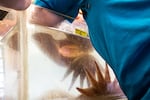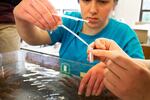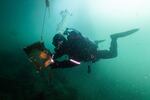Jason Hodin buried his face in a microscope. Like many biologists, he spends much of his time viewing life at the micro level. Using a pipette — a tool that transfers precise amounts of liquid — he methodically sifted through a small bowl of water containing thousands of amoeba-shaped sea star larvae in his lab on Washington’s San Juan Island. Over time, tiny dust particles and debris fall into the bowl, putting the larvae in danger of contamination.
“We spend a fair amount of time every four days looking at a whole bunch of larvae in the microscope and pulling out what we call, in technical terms, the crud,” he said. “Sometimes I also refer to it as schmutz.”
Hodin runs the world’s first captive breeding program for Pycnopodia helianthoides, commonly known as the sunflower sea star.
The small University of Washington laboratory in Friday Harbor, Washington, may seem unremarkable to the casual observer, but in February when Hodin looked at the tanks teeming with juvenile pycnos, as he calls them for short, he was reminded of the groundbreaking research he and his team are engaging in.
“It’s like the most enjoyable thing that I could possibly imagine,” Hodin said. “Being able to see these stars grow from embryos to these incredible larval stages that undergo this incredible metamorphosis. I mean, this is an amazing thing to be able to witness.”

Research scientist Jason Hodin looks through a microscope at the University of Washington's Friday Harbor Labs on San Juan Island, Wash., in February.
Noah Thomas / OPB
The sunflower sea star is the largest sea star on earth, boasting an arm span of up to 3 feet and growing as many as 24 limbs. Thousands of tiny tube feet allow them to be incredibly agile with the ability to travel roughly 1 meter per minute, which is Olympic speed for a sea star. They also have 360-degree vision — they can see in all directions — thanks to compound eyes at the tip of each arm.
While some of these sea stars can still be spotted throughout the San Juan Islands archipelago, the same can’t be said of the vast coastal territory they once inhabited.
At one point, hundreds of millions of pycnos flourished across a giant coastal region from Alaska to Mexico. However, in 2013, a mysterious condition known as wasting led to mass starfish die-offs. Sunflower stars were severely impacted, with their populations along the Pacific Coast dwindling by more than 90%. In 2020, the species was declared critically endangered on the West Coast, and it is being considered for protection under the Endangered Species Act.
For several years now, Hodin has been successfully spawning wild pycnos collected from the coasts of San Juan and other local islands in an effort to rebuild the population. Although scientists have been aware of wasting disease since the late ‘70s, he said, they still have much to learn about the condition.
“Unfortunately, there’s a lot of speculation and not a lot of really good data,” Hodin said. “And the reason is because we still don’t know the cause of sea star wasting.”
The cause of wasting remains unknown, but its detrimental impacts are all too visible. Lesions are a common symptom, followed by the loss of limbs and ultimately complete decomposition.
Fiona Curliss, who works as a research assistant in Friday Harbor, interacts with pycnos on a weekly basis and is acutely aware of how devastating wasting can be.
“They’ll just start, without prompting, losing arms,” Curliss said. “And this can happen to one arm or many — the majority of the star, even.”
A glimmer of hope
Hodin started the captive breeding program at Friday Harbor because he saw a potential solution in the remaining pycnos that demonstrated resilience against the disease.
“We lost somewhere around 90% of the sunflower stars, which is hundreds of millions of animals,” Hodin said. “As horrible as that is, what that suggests is that the ones that didn’t die probably had a little bit of resistance. And if two of those stars breed, we think that their offspring are likely to be even more fit in response to the disease.”
The goal of the program is to raise multiple generations of stars that are more resistant to wasting. Many of the stars will eventually be released into the wild and begin a gradual process of rebuilding their populations.
Prior to Hodin’s research, no scientist had ever attempted to breed wild-caught sunflower sea stars.
At his lab last February, he upped the ante by attempting to breed what’s known as an F2 generation. For the past three years, his team had been meticulously caring for the first generation, F1, born in the lab from wild-caught parents, and now they were attempting to see if these lab-born stars can successfully breed.
“The F1 is the first offspring that you produce from wild stock,” Curliss said. “The F2 being the first generation produced from that first captive-bred generation means you can fully reproduce the lifecycle in captivity, which is a big deal.”

Research scientist Jason Hodin selects sunflower stars for breeding in February at Friday Harbor Labs on San Juan Island, Wash.
Noah Thomas, Noah Thomas / OPB
Ushering in a new generation
The lab was full of anticipation as Hodin grabbed a 5-gallon bucket and headed for the pycno tanks just outside the building.
“We’re about to select six stars that were born in 2019 and that are now a little bit over 3 years old,” he said. “And we’re going to attempt to spawn them for the first time. We think they might be reproductive this year.”
One by one, Hodin scooped up stars from their tanks and carefully placed them in the bucket. After selecting the six candidates, he headed back into the lab.
“Bucket of stars!” he calls out. It’s followed by a smattering of cheers from the lab staff.
The lab assistants sprung into action, weighing and measuring each star and counting their arms. Aside from slight color variations, it can be extremely difficult to tell pycnos apart, so documenting every minor detail is essential. If that weren’t enough, sunflower stars aren’t sexually dimorphic, meaning there’s no way to distinguish males from females.
“From the outside I couldn’t look at one in the wild and say, this is a male, this is a female,” Curliss said. “They look exactly the same, so you have to rely on when they spawn because that’s going to be pretty obvious.”
Hodin and the assistants injected the stars with a spawning hormone, 1-methyladenine. Within a span of a couple hours the hormone should prompt the males to release sperm, with females discharging eggs a few hours later. Since no one — including Hodin — has ever attempted to spawn lab-raised stars, they can’t be certain whether the pycnos have reached reproductive maturity. All they can do now is wait.
A delicate balance
Sunflower sea stars are a keystone species for ecosystems along the West Coast, which means they play a critical role in the surrounding habitats. Pycnos especially love to feed on sea urchins, and in the absence of these predatory stars, urchin populations have begun to surge. This has led to the depletion of kelp forests, a primary food source for urchins.
“When you lose pycnopodia from the environment, you are losing the predator that keeps the population in check,” Curliss said. “Urchin populations have exploded, and they have just been decimating kelp forests.”
Kelp forests are one of the most productive and dynamic ecosystems on Earth. They play a critical role in sustaining marine environments and provide a myriad of ecological benefits. Some even consider them to be rainforests of the ocean.
“Kelp forests are rather important because they create a lot of oxygen and they suck up a lot of CO2,” Curliss said. “The hope is that maybe the reintroduction of pycnopodia will help take down the urchin population and help flip things back over to a kelp forest environment.”

University of Washington research assistant Fiona Curliss inspects sunflower stars for sperm in February at Friday Harbor Labs on San Juan Island, Wash.
Noah Thomas / OPB
Two to tango
Two hours after the scientists injected the stars, Hodin noticed something. He grabbed a pipette and stuck it into a large tank housing the six pycnos. He sucked up some water and squeezed it into a small bowl.
“There’s just the ever-tiniest little bit of sperm,” Hodin said. “I’m sure he’s going to spawn a little more, but you see the cloudiness in that?”
Sure enough, the water in the bowl was slightly opaque with pycno sperm. Hodin scooped up the spawning star and transferred him to a different tank. They want to try to control which sperm is fertilizing which egg, and so males are separated as soon as they’re identified.
Hodin squeezed some of the cloudy water into a test tube and used a centrifuge to separate the sperm from the water. He then placed the newly gathered sperm under a microscope for inspection.
“Oh yeah. Lots of swimming sperm,” he said. “It’s a good sign.”
Not long after, another pycno began to release sperm. And another. Eventually all six stars were able to spawn, but there was one problem — they were all male.
“We are so far getting only males,” Hodin said.
“You kind of need two to tango,” Curliss interjected.
Hodin brought in a few more pycnos from the tanks outside and injected them with the same spawning hormone. All of the stars eventually spawned, and they, too, were all male. Without a single female to produce eggs, the fertilization experiment was at a standstill. Hodin’s backup plan was to spawn one of their adult females that he knew has been fertile in the past.

Research assistant Fiona Curliss transfers sperm using a pipette at Friday Harbor Labs on San Juan Island, Wash.. in February.
Noah Thomas / OPB
Closing the loop
The following day, Hodin went with his backup plan of injecting a giant purple sunflower sea star the scientists nicknamed Prospero after they brought it in from the wild a few years back.
“Prospero as a female, has spawned a couple of times for us in the past,” Hodin said. “If she spawns, then we can at least get offspring that are half from the wild and half from our broodstock, which would be the first time that’s ever happened too. So that’s still worthwhile.”
After about four hours, Hodin noticed an orange-yellowish substance beginning to accumulate on the surface of Prospero’s body. He leaned in to take a closer look. Indeed, Prospero was releasing eggs.
“Prospero is spawning,” Hodin said. “Now we have some eggs that we can use with the sperm that we got from yesterday.”
Hodin used a pipette to extract the eggs and mixed them with yesterday’s sperm inside of a beaker. He then examined a sample of the mixed liquid under a microscope.
“I’m seeing fertilization,” he said. “At least now we have the capacity for the first time to close the loop on the lifecycle. In other words, to raise a batch of larvae where at least one of the parents was born in captivity themselves. So it’s pretty exciting.”
For scientists like Hodin, successful fertilization is a true milestone. But before they could start releasing stars along the West Coast, one final consideration remained: figuring out whether or not these lab-raised stars could survive in the wild ocean.
Into the wild
It was early morning on a Saturday in July, and Joey Ullman was suiting up for an underwater dive. As the dive lead for Friday Harbor’s captive breeding program, Ullman’s job is to reintroduce the lab-grown sea stars into the ocean to see whether they can survive on their own and not immediately succumb to wasting. By keeping them in cages, he’s able to closely track their progress over time.
“We’re going to check out the out-planted sunflower star subtidal cages,” Ullman said. “The lab stars are doing particularly well — a really good indicator that this whole project has a fairly tractable future.”
The custom-built cages, which are situated just off the dock at Friday Harbor, provide a controlled environment for testing and observation prior to releasing the stars into the wild.

Diver Joey Ullmann inspects sunflower stars inside a cage at Friday Harbor Labs on San Juan Island, Wash., in July.
Stephani Gordon / OPB
“We do have our eyes on this idea of releasing into the wild,” Hodin said. “And we want to make sure that the stars that we release out there are fit and that they’re going to survive in that context.”
Beyond the environmental consequences of dwindling sunflower sea star populations, Curliss said she thinks about the philosophical question of a species’ right to live. What compels us, as humans, to step in and address such issues?
“We’ve altered the planet in a lot of ways that have made it rather inhospitable for many species, and we’ve lost a lot of them,” Curliss said. “And I think whether or not something is relevant to medical research or to the greater environmental impact, all species deserve to have that fighting chance to continue existing.”
Hear more about the quest to breed a new generation of sunflower sea stars in the audio player below.

